General Description
TSL2591
Light-to-Digital Converter
The TSL2591 is a very-high sensitivity light-to-digital converter
that transforms light intensity into a digital signal output
capable of direct I²C interface. The device combines one
broadband photodiode (visible plus infrared) and one
infrared-responding photodiode on a single CMOS integrated
circuit. Two integrating ADCs convert the photodiode currents
into a digital output that represents the irradiance measured
on each channel. This digital output can be input to a
microprocessor where illuminance (ambient light level) in lux
is derived using an empirical formula to approximate the
human eye response. The TSL2591 supports a traditional level
style interrupt that remains asserted until the firmware clears it.
Ordering Information and Content Guide appear at end of
datasheet.
Figure 1:
Added Value of Using TSL2591
Benefits
Features
• Approximates Human Eye Response
• Dual Diode
• Flexible Operation
• Programmable Analog Gain and Integration Time
• Suited for Operation Behind Dark Glass
• 600M:1 Dynamic Range
• Low Operating Overhead
• Two Internal Interrupt Sources
• Programmable Upper and Lower Thresholds
• One Interrupt Includes Programmable Persistence Filter
• Low Power 3.0 μA Sleep State
• User Selectable Sleep Mode
• I²C Fast Mode Compatible Interface
• Data Rates up to 400 kbit/s
• Input Voltage Levels Compatible with 3.0V Bus
ams Datasheet
[v2-04] 2018-Jun-05
Page 1
Document Feedback
�
TSL2591 − General Description
Block Diagram
The functional blocks of this device are shown below:
Figure 2:
Block Diagram
Page 2
Document Feedback
ams Datasheet
[v2-04] 2018-Jun-05
�
TSL2591 − Detailed Description
Detailed Description
The TSL2591 contains two integrating analog-to-digital
converters (ADC) that integrate currents from two photodiodes.
Integration of both channels occurs simultaneously. Upon
completion of the conversion cycle, the conversion result is
transferred to the Channel 0 and Channel 1 data registers,
respectively. The transfers are double-buffered to ensure that
the integrity of the data is maintained. After the transfer, the
device automatically begins the next integration cycle.
Communication with the device is accomplished through a
standard, two-wire I²C serial bus. Consequently, the TSL2591
can be easily connected to a microcontroller or embedded
controller. No external circuitry is required for signal
conditioning. Because the output of the device is digital, the
output is effectively immune to noise when compared to an
analog signal.
The TSL2591 also supports an interrupt feature that simplifies
and improves system efficiency by eliminating the need to poll
a sensor for a light intensity value. The primary purpose of the
interrupt function is to detect a meaningful change in light
intensity. The concept of a meaningful change can be defined
by the user both in terms of light intensity and time, or
persistence, of that change in intensity. The device has the
ability to define two sets of thresholds, both above and below
the current light level. An interrupt is generated when the value
of a conversion exceeds either of these limits. One set of
thresholds can be configured to trigger an interrupt only when
the ambient light exceeds them for a configurable amount of
time (persistence) while the other set can be configured to
trigger an immediate interrupt.
ams Datasheet
[v2-04] 2018-Jun-05
Page 3
Document Feedback
�
Pin Assignment
The TSL2591 pin assignments are described below.
TSL2591 − Pin Assignment
Package FN Dual Flat No-Lead (Top
View): Package drawing is not to scale.
Figure 3:
Pin Diagram
SCL 1
INT 2
GND 3
6 SDA
5 VDD
4 NC
Figure 4:
Pin Description
Pin Number
Pin Name
Description
1
2
3
4
5
6
SCL
INT
GND
NC
VDD
SDA
I²C serial clock input terminal
Interrupt — open drain output (active low).
Power supply ground. All voltages are referenced to GND.
No connect — do not connect.
Supply voltage
I²C serial data I/O terminal
Page 4
Document Feedback
ams Datasheet
[v2-04] 2018-Jun-05
�
TSL2591 − Absolute Maximum Ratings
Absolute Maximum Ratings
Figure 5:
Absolute Maximum Ratings
Stresses beyond those listed under Absolute Maximum Ratings
may cause permanent damage to the device. These are stress
ratings only. Functional operation of the device at these or any
other conditions beyond those indicated under Recommended
Operating Conditions is not implied. Exposure to absolute
maximum rating conditions for extended periods may affect
device reliability.
Parameter
Min Max Units
Comments
Supply voltage, VDD
Input terminal voltage
Output terminal voltage
Output terminal current
Storage temperature range, Tstg
ESD tolerance, human body model
ESD tolerance, charge device model
(CDM)
3.8
3.8
3.8
20
85
-0.5
-0.5
-1
-40
±2000
±500
V
V
V
mA
ºC
V
V
All voltages are with respect to GND
JESD22-A114-B
JESD22-C101
ams Datasheet
[v2-04] 2018-Jun-05
Page 5
Document Feedback
�
TSL2591 − Electrical Characteristics
All limits are guaranteed. The parameters with min and max
values are guaranteed with production tests or SQC (Statistical
Quality Control) methods. Device parameters are guaranteed
at TA = 25°C unless otherwise noted.
Electrical Characteristics
Figure 6:
Recommended Operating Conditions
Symbol
VDD
TA
Parameter
Supply voltage
Operating free-air temperature
Min
2.7
-30
Typ
3
Max
Units
3.6
70
V
ºC
Figure 7:
Operating Characteristics, VDD=3V, TA=25ºC (unless otherwise noted)
Symbol
Parameter
Conditions
Min
IDD
VOL
ILEAK
VIH
VIL
Supply current
Active
Sleep state - no I²C activity
INT, SDA output low
voltage
3mA sink current
6mA sink current
Leakage current, SDA,
SCL, INT pins
SCL, SDA input high
voltage
SCL, SDA input low
voltage
TSL25911 (Vbus = VDD)
TSL25913 (Vbus = 1.8)
TSL25911 (Vbus = VDD)
TSL25913 (Vbus = 1.8)
0
0
-5
0.7 VDD
1.26
Typ
275
2.3
Max
Units
325
4
0.4
0.6
5
0.3 VDD
0.54
μA
V
μA
V
V
Page 6
Document Feedback
ams Datasheet
[v2-04] 2018-Jun-05
�
TSL2591 − Electrical Characteristics
Figure 8:
ALS Characteristics, VDD=3V, TA=25ºC, AGAIN = High, AEN=1, (unless otherwise noted)(1) (2) (3)
Parameter
Conditions
Channel
Min
Typ
Max
Units
Ee = 0,
AGAIN = Max,
ATIME=000b (100ms)
CH0
CH1
0
0
20
20
counts
ATIME = 000b (100ms)
95
100
105
ms
Dark ADC count
value
ADC integration
time step size
ADC number of
integration steps (4)
Max ADC count
ATIME = 000b (100ms)
Max ADC count
ATIME = 001b (200ms), 010b
(300ms), 011b (400ms),
100b (500ms), 101b (600ms)
ADC count value
White light (2)
Ee = 4.98 μW/cm2
ATIME = 000b (100 ms)
λp = 850 nm (3)
Ee = 5.62 μW/cm2,
ATIME = 000b (100 ms)
ADC count value
ratio: CH1/CH0
White light (2)
λp = 850 nm (3)
Re
Irradiance
responsivity
Noise (4)
White light (2)
ATIME = 000b (100 ms)
λp = 850 nm (3)
ATIME = 000b (100 ms)
White light (2)
Ee = 4.98 μW/cm2
ATIME = 000b (100 ms)
CH0
CH1
CH0
CH1
CH0
CH1
CH0
CH1
CH0
1
0
0
1120
1230
6
steps
36863
counts
65535
counts
1510
counts
1665
counts
1315
174
1447
866
0.092
0.132
0.172
0.558
0.598
0.638
264.1
34.9
257.5
154.1
counts/
(μW/cm2)
1
2
1 standard
deviation
ams Datasheet
[v2-04] 2018-Jun-05
Page 7
Document Feedback
�
Parameter
Conditions
Channel
Min
Gain scaling, relative
to 1× gain setting
(AGAIN = Low)
AGAIN = Med
AGAIN = High
AGAIN = Max
CH0
CH1
CH0
CH1
CH0
CH1
22
22
360
360
8500
9100
TSL2591 − Electrical Characteristics
Typ
24.5
24.5
400
400
9200
9900
Max
Units
27
27
440
440
9900
10700
×
Note(s):
1. Optical measurements are made using small-angle incident radiation from light-emitting diode optical sources. Visible white LEDs
and infrared 850 nm LEDs are used for final product testing for compatibility with high-volume production
2. The white LED irradiance is supplied by a white light-emitting diode with a nominal color temperature of 4000 K.
3. The 850 nm irradiance is supplied by a GaAs light-emitting diode with the following typical characteristics: peak wavelength λp =
850 nm and spectral halfwidth Δλ½ = 42 nm.
4. Parameter ensured by design and is not 100% tested.
Page 8
Document Feedback
ams Datasheet
[v2-04] 2018-Jun-05
�
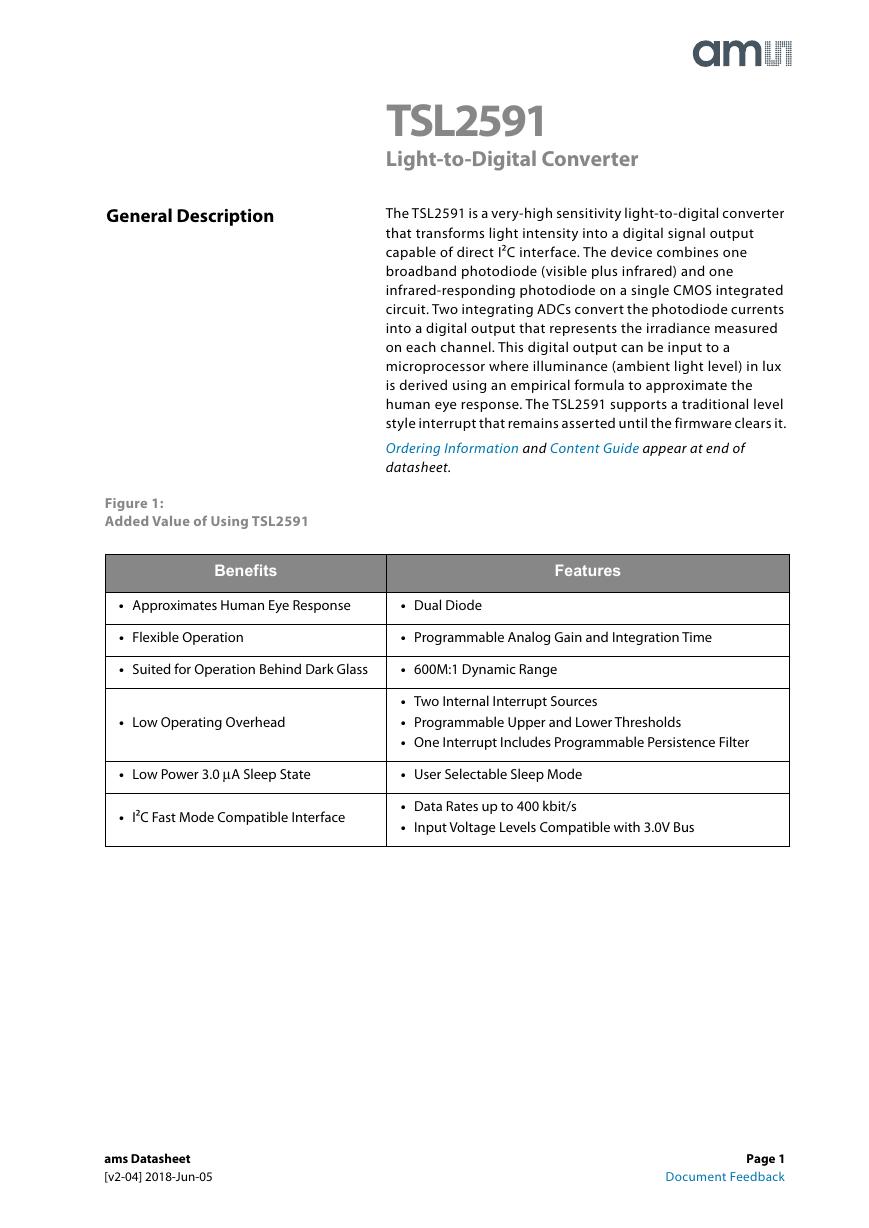
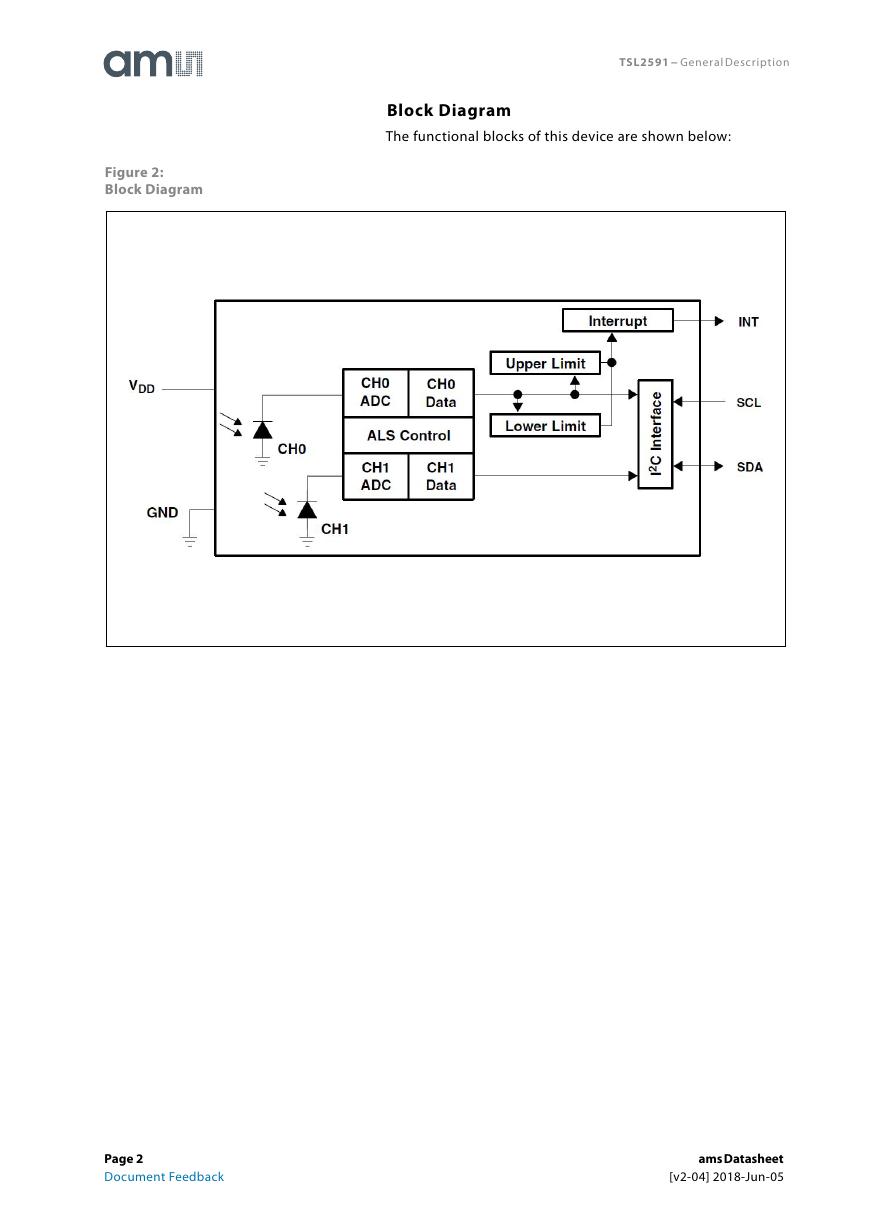
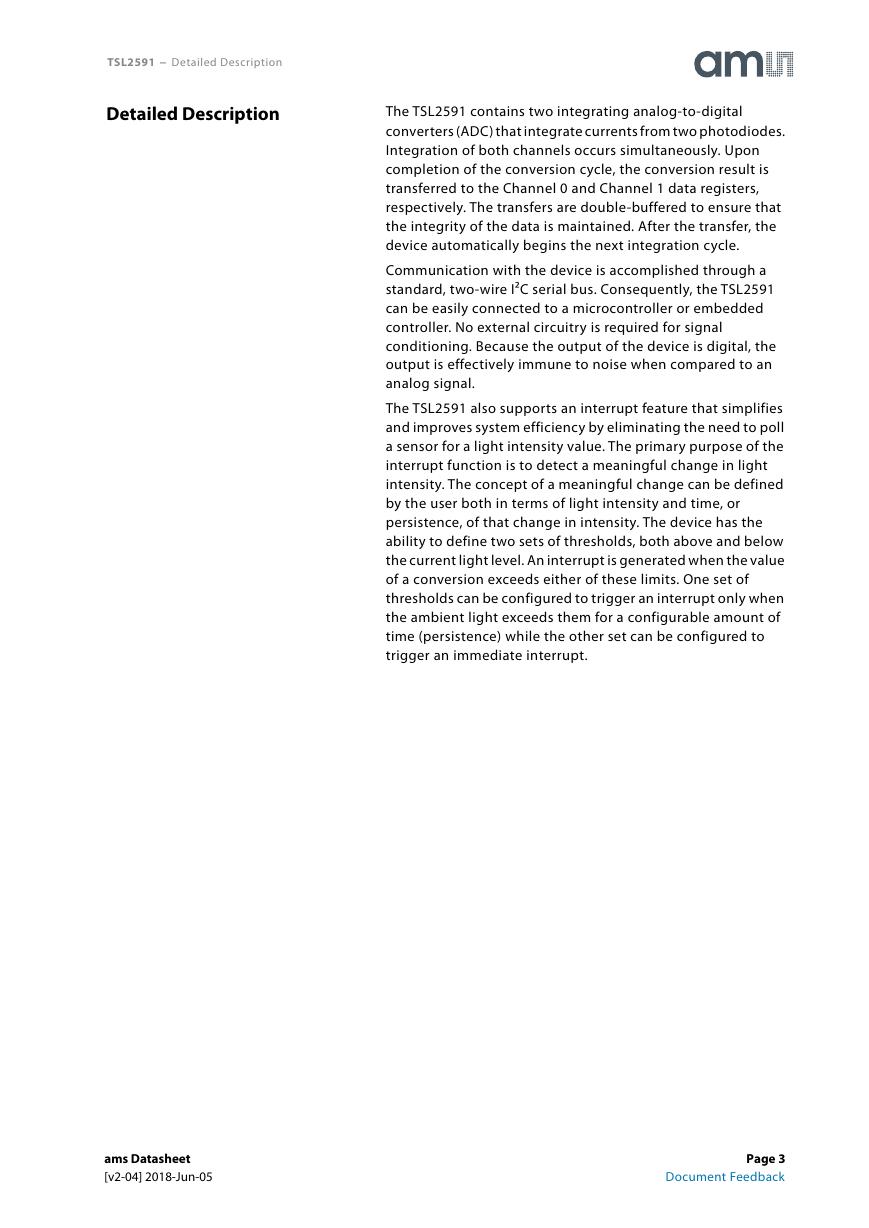
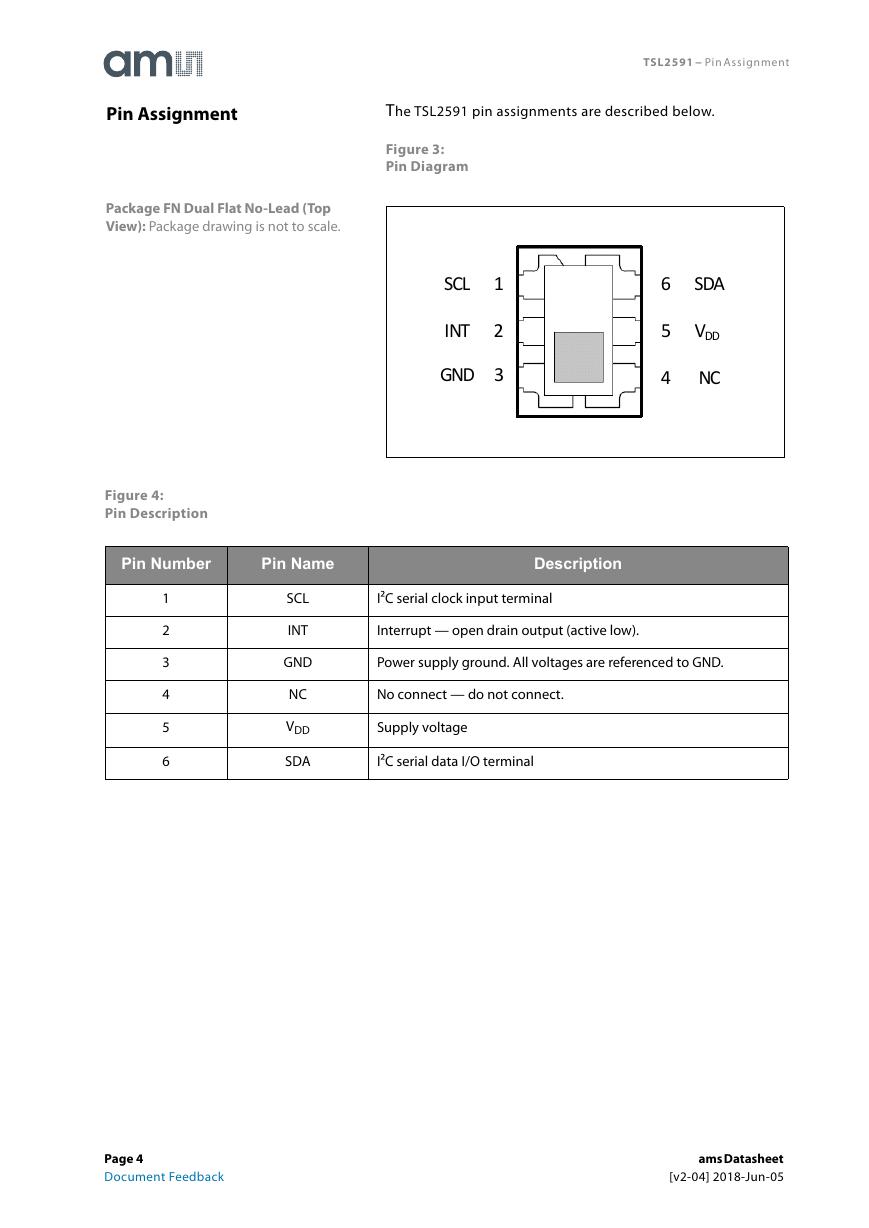
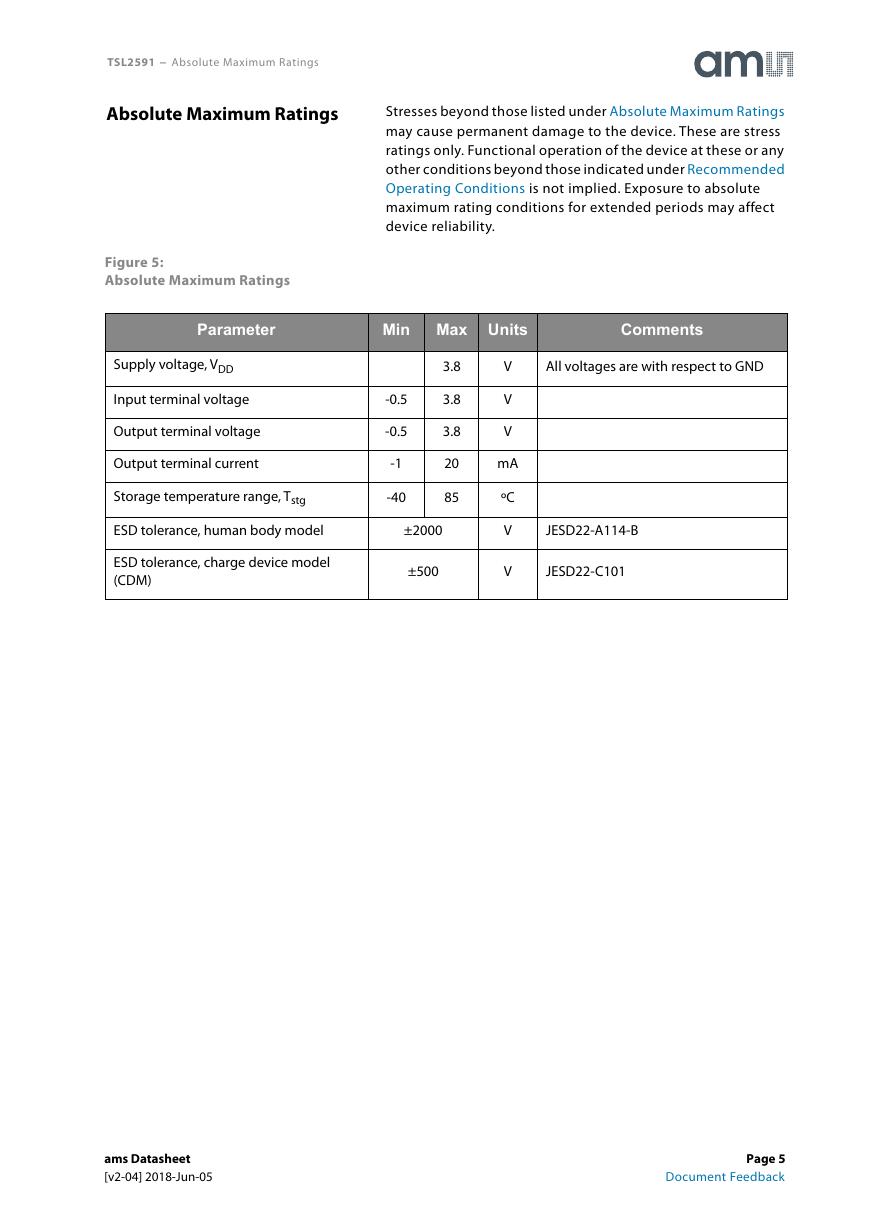
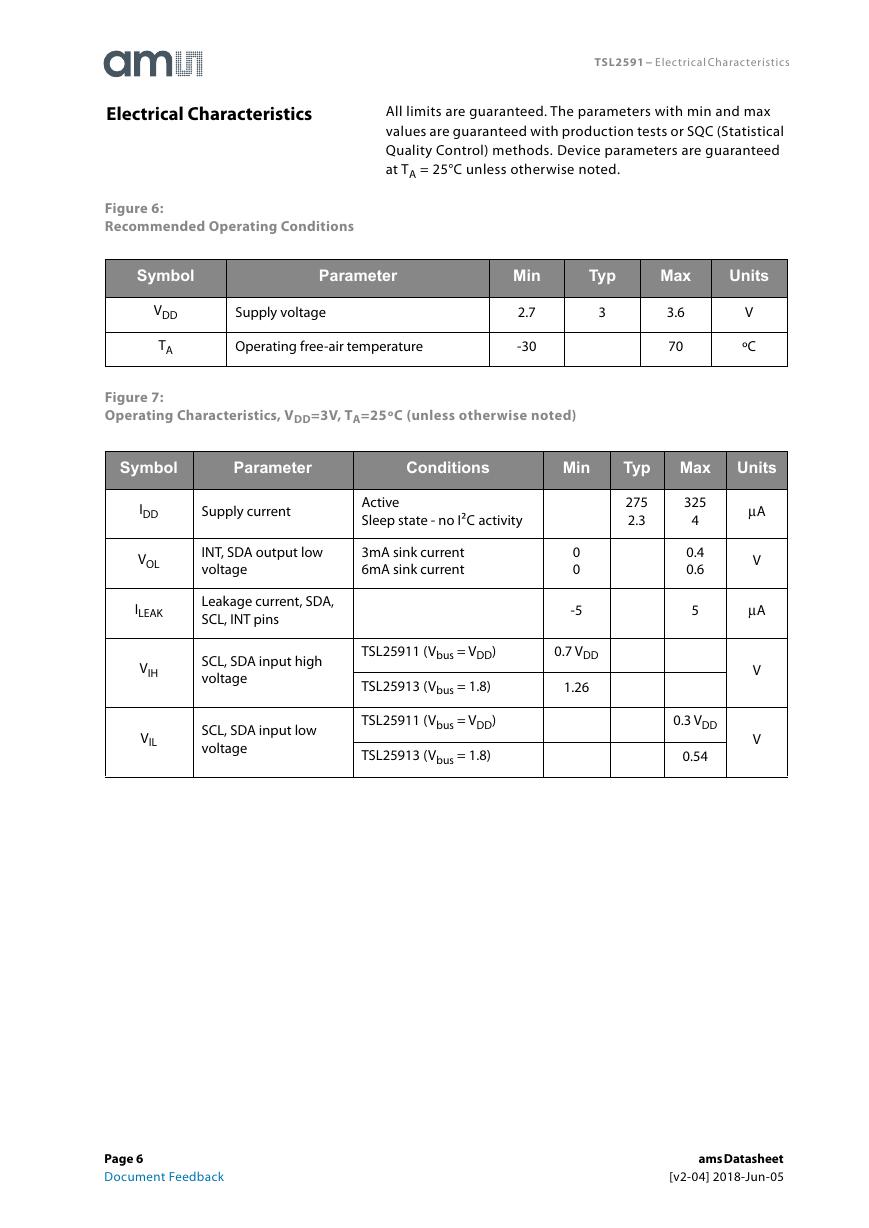
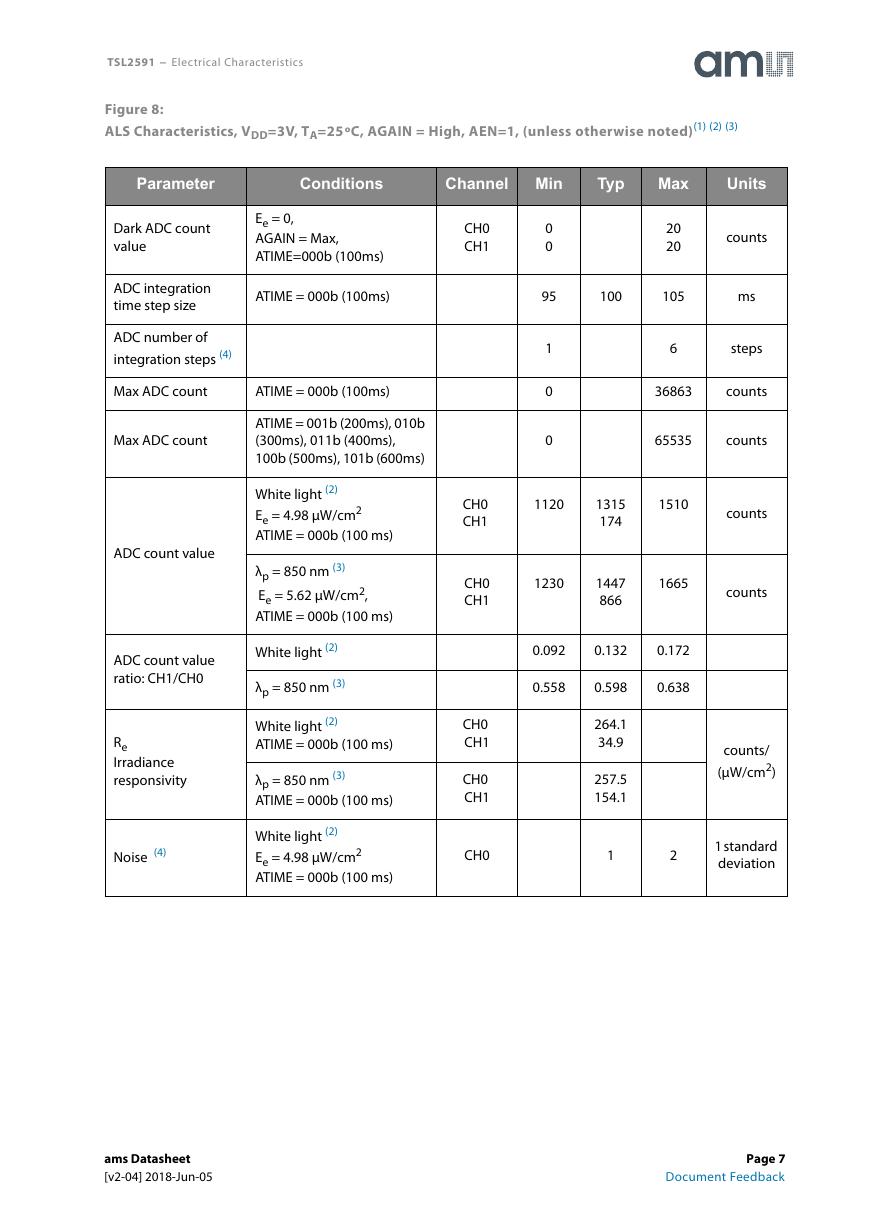









 V2版本原理图(Capacitive-Fingerprint-Reader-Schematic_V2).pdf
V2版本原理图(Capacitive-Fingerprint-Reader-Schematic_V2).pdf 摄像头工作原理.doc
摄像头工作原理.doc VL53L0X简要说明(En.FLVL53L00216).pdf
VL53L0X简要说明(En.FLVL53L00216).pdf 原理图(DVK720-Schematic).pdf
原理图(DVK720-Schematic).pdf 原理图(Pico-Clock-Green-Schdoc).pdf
原理图(Pico-Clock-Green-Schdoc).pdf 原理图(RS485-CAN-HAT-B-schematic).pdf
原理图(RS485-CAN-HAT-B-schematic).pdf File:SIM7500_SIM7600_SIM7800 Series_SSL_Application Note_V2.00.pdf
File:SIM7500_SIM7600_SIM7800 Series_SSL_Application Note_V2.00.pdf ADS1263(Ads1262).pdf
ADS1263(Ads1262).pdf 原理图(Open429Z-D-Schematic).pdf
原理图(Open429Z-D-Schematic).pdf 用户手册(Capacitive_Fingerprint_Reader_User_Manual_CN).pdf
用户手册(Capacitive_Fingerprint_Reader_User_Manual_CN).pdf CY7C68013A(英文版)(CY7C68013A).pdf
CY7C68013A(英文版)(CY7C68013A).pdf TechnicalReference_Dem.pdf
TechnicalReference_Dem.pdf